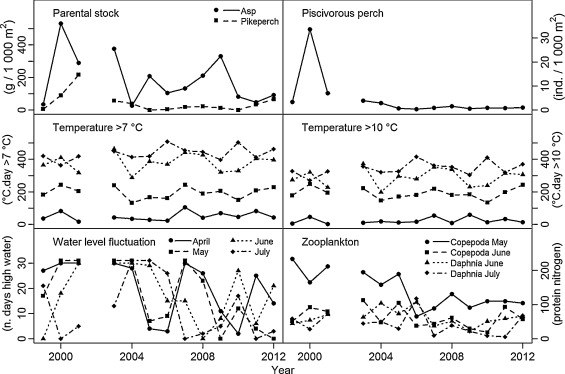 Fish recruitment in riverine reservoirs is not fully understood because the long-term data series required for standard stock–recruitment models are often lacking. In this study, two unrelated piscivorous species with different ecologies, asp (Leuciscus aspius) and pikeperch (Sander lucioperca), were investigated over a 14-year period in a reservoir in the Czech Republic using a novel informative statistical approach based on dimension reduction methods. This method is useful for situations in which potential predictors are equal to, or exceed, the length of the time series. Recruitment of asp fry was affected by zooplankton abundance, predator density and temperature. Recruitment of pikeperch fry measured with seine and trawls was only affected by the number of predators, while recruitment of pikeperch fry estimated with gillnet data was also affected by temperature and water level fluctuation. Although gillnets are commonly used sampling method, it seems to be inappropriate for developing fry predicting model. This research also highlights the use of a novel approach to dimension reduction for analysis of factors affecting recruitment using shorter time series (in our case 13 years).
Fish recruitment in riverine reservoirs is not fully understood because the long-term data series required for standard stock–recruitment models are often lacking. In this study, two unrelated piscivorous species with different ecologies, asp (Leuciscus aspius) and pikeperch (Sander lucioperca), were investigated over a 14-year period in a reservoir in the Czech Republic using a novel informative statistical approach based on dimension reduction methods. This method is useful for situations in which potential predictors are equal to, or exceed, the length of the time series. Recruitment of asp fry was affected by zooplankton abundance, predator density and temperature. Recruitment of pikeperch fry measured with seine and trawls was only affected by the number of predators, while recruitment of pikeperch fry estimated with gillnet data was also affected by temperature and water level fluctuation. Although gillnets are commonly used sampling method, it seems to be inappropriate for developing fry predicting model. This research also highlights the use of a novel approach to dimension reduction for analysis of factors affecting recruitment using shorter time series (in our case 13 years).
Keywords: asp; Leuciscus aspius; pikeperch; Sander lucioperca; sliced inversion regression; stock–recruitment; temperature; water level fluctuations; zooplankton
